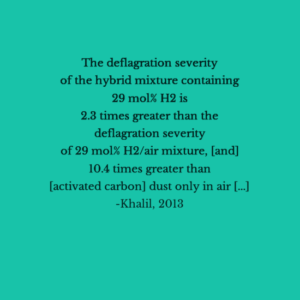1-Sentence-Summary: Addition of small amounts of hydrogen gas to activated carbon dust has little impact on explosion violence, while hybrid mixtures near the gas stoichiometric concentration are more severe than pure hydrogen at the same concentrations.
Authors: Y. Khalil
Read in: Three Minutes
Favourite quote from the paper:

The author of this paper performs explosion testing of activated carbon dust and hydrogen gas mixtures. The carbon dust is sieved through a < 75 µm screen and is tested from 30 to 500 g/m3. The hydrogen gas is tested at concentrations of 2, 4, 6, and 29% by volume.
Maximum pressure and maximum rate of pressure rise is presented for the hybrid mixtures based on ASTM E1226-12 test conditions. 10 kJ chemical ignitors are used along with a 60 ms delay time. Minimum explosibility testing is also completed based on ASTM E-1515-09 using a 2.5 kJ ignitor.
Three of the main findings from this paper are:
- Addition of hydrogen gas under fuel-lean concentrations does not enhance the activate carbon dust explosions under the conditions tested.
- At stoichiometric hydrogen concentrations the addition of activated carbon dust significantly increases explosion severity.
- Explosions occur when both of the fuels are below their flammability limits.
The following sections outline the main findings in more detail. The interested reader is encouraged to view the complete article at the link provided below.
Finding #1: Activated carbon dust explosions are minimally affected by lean concentrations of hydrogen gas.
The explosion tests demonstrated that the addition of hydrogen gas had a lowering effect on maximum pressure and maximum rate of pressure rise. Maximum pressure throughout the dust concentration range was between 7.5 and 8 bar with highest value occurring without any hydrogen gas added. Maximum rate of pressure rise was between 350 and 400 bar/s and also had the highest value without gas addition.
Finding #2: Explosion severity of stoichiometric hydrogen is significantly increased by the presence of activated carbon dust
Contrary to other papers published in the literature (e.g., Garcia-Agreda et al., 2011 and Sanchirico et al., 2011), the current authors found that the stoichiometric gas concentration was not the worse case scenario for the hybrid mixture. They reported that that the maximum rate of pressure rise increased from 1000 bar/s for pure hydrogen to more than 4000 bar/s for the hybrid mixture. They also found that the worst case conditions occurred at very low dust concentrations of 20 g/m3.
Finding #3: Hybrid explosions can occur when both fuels are below their respective flammability limits.
The minimal explosible concentration testing showed that explosions can occur when both fuels are below their respective flammability limits. From analyzing the data in the paper, it can be shown that the hybrid flammability limits are narrower than the predictions of Le Chatelier’s Law. This is consistent with other findings in the literature using hydrogen gas (e.g., Addai et al., 2015).
My Personal Take-Aways From
“Experimental Investigation of the Complex Deflagration Phenomena of Hybrid Mixtures of Activated Carbon Dust/Hydrogen/Air”
This paper presents some very interested explosion results for mixtures of hydrogen gas and activated carbon dust. A thorough overview of the hybrid dust explosion literature and potential accident scenarios is also given. The explosion data is well organized and could be used in subsequent studies e.g., to explore explosion regime diagrams for this fuel as done by Garcia-Agreda et al., 2011 and Sanchirico et al., 2011
The finding that the addition of hydrogen gas at lean concentrations has little impact on the activated carbon explosion violence is very interesting. It is possible that this is related to the heterogeneous reaction mechanism of the carbon dust. It should be noted that this behavior is not typical of the homogeneously reacting dust studied in the hybrid explosion literature.
The enhancement of explosion violence from adding activated carbon dust to stoichiometric hydrogen gas is alarming (moving from 1000 to 4500 bar/s). This 4.5 times increase is much larger than reported by previous studies at fuel lean concentrations (Denkevits, 2007). It is possible that the high flame temperature of hydrogen and the greatly enlarged surface area of the activated carbon allows for very rapid heating and oxidation. It would be interesting to analyze the explosion products as was done by Denkevits, 2007 to see how much of the hydrogen reacts during these tests. It is also unclear what role turbulence plays in these results.
Full Citation: [bibtex file=references.bib key=Khalil2013]
[otw_shortcode_button href=”http://www.sciencedirect.com/science/article/pii/S0950423013000818″ size=”medium” icon_position=”left” shape=”square”]> > Get The Article[/otw_shortcode_button]
